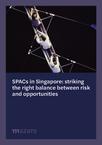
SPACs in Singapore: striking the right balance between risk and opportunities
Singapore is among the first in Asia to introduce SPAC listings in its bourse, with a new framework taking effect on 3 September 2021. Private companies looking to take the plunge and go public will immensely benefit from evaluating the potential risks and rewards that come with SPAC transactions. Below, Rick Chan, Managing Partner and Head of Audit & Assurance in APAC and Chee Keong Ooi, Partner, Audit & Assurance share their expert insights.
Q. What is a SPAC and what does this move mean for Singapore?
SPAC, a Special Purpose Acquisition Company, is also known in the vernacular as a “Blank Check Company” with no prior operating history. The entity concept has come in and out of fashion since the 1990’s, depending on a number of factors including market liquidity and appetite for risk for new technologies.
Armed with a promising acquisition strategy, SPACs are established solely for the purpose of creating opportunities to raise capital for acquisition or combination of entities (“de-SPAC” transactions). SPACs are generally formed and financed by individuals or hedge funds, known as sponsors, who have expertise in management and deal advisory. Once the initial case is raised, SPACs have a set timeframe to identify a target company or companies to include in the SPAC and close the deal.
In the framework released by the Singapore Exchange (SGX), a SPAC listing must have the following key features:
- Minimum market capitalisation of S$150 million
- De-SPAC must take place within 24 months of IPO with an extension of up to 12 months subject to fulfilment of prescribed conditions
- Moratorium on Sponsors’ shares from IPO to de-SPAC, a 6-month moratorium after de-SPAC and for applicable resulting issuers, a further 6-month moratorium thereafter on 50% of shareholdings.
- Sponsors must subscribe to at least 2.5% to 3.5% of the IPO shares/units/warrants depending on the market capitalisation of the SPAC
- De-SPAC can proceed if more than 50% of independent directors approve the transaction and more than 50% of shareholders vote in support of the transaction
- Warrants issued to shareholders will be detachable and maximum percentage dilution to shareholders arising from the conversion of warrants issued at IPO is capped at 50%
- All independent shareholders are entitled to redemption rights
- Sponsor’s promote limit of up to 20% of issued shares at IPO
SPACs accounted for more than 50% of new publicly listed US companies last year. With this new announcement, SPACs are expected to help revive Singapore’s declining IPO business. This trend is projected to rise in the coming years, fuelled by the growth of innovative nascent companies in Southeast Asia, particularly in sectors like tech and fintech.
While the explosive growth of SPACs presents itself as a viable alternative to the traditional Initial Public Offerings (IPOs), we need to carefully consider both the opportunities and risks that they pose to investors and companies alike.
Q. What are the reasons behind SPAC’s spectacular rise?
Going public is a significant milestone for businesses, and SPACs are increasingly gaining popularity for a number of reasons.
A key advantage is the speed of market entry. The process of taking private companies public via the SPAC route is significantly faster than the year-long IPO process. The Covid-19 pandemic has injected uncertainty into the market, so a shorter timeline is desirable to SPAC sponsors or private companies seeking large amounts of capital ad liquidity. The financial benefits of raising capital are aplenty, from paying off debts and investing in new growth opportunities.
SPACs also provides greater certainty through an upfront price discovery. With the volatility seen in the stock market this year, timing the market remains a major concern for companies planning to make a traditional debut. Missing an IPO window by as little as one day can be disastrous.
Going public through SPAC structures offers target companies added assurance from investors right from the beginning. The alternative investment vehicle allows companies to negotiate an exact purchase price and better terms to maximise their valuation. A SPAC may also be willing to undertake a transaction with a company in an earlier stage than the usual IPO candidate.
Q. What are the risks we need to look out for?
Companies and investors need to be aware of the potential risks involved in SPACs in order to make informed decisions.
While the short timeframe is primarily viewed in a positive light, sponsors face pressure to target and acquire viable companies to meet their merger deadlines. Combined with minimal working capital, this situation may lead to further difficulties down the line.
Secondly, there is insecurity involved with valuing acquisition targets. Private companies are not obligated to report earnings and they may have bad financials due to cashflow issues. Price declines can also occur where the financial prospects and risks of the target companies are assessed inaccurately, leading to adverse results.
Another commonly underestimated challenge is the technical accounting and finance functions required in SPAC transactions. Some may find it a challenge to meet the extensive regulatory requirements under a condensed timeline. Similar to an IPO, companies need to prepare a business combination agreement and related ancillary documents. Going through a rigorous due diligence process is also critical to avoid any regulatory snags.
Q. How can we avoid the pitfalls of a SPAC transaction?
The reality is, not all SPACs are thriving and profitable. According to a Goldman Sachs study[1], many SPACs tend to underperform the broader market in the long term as interest rates climb.
Public listing transactions require broad expertise in project management, accounting, tax, internal controls and governance along with dedicated resources to plan, stage, and execute the SPAC efforts. In order to avoid potential pitfalls, building a quality advisory team is essential before embarking on this important journey.
Anticipation, expert advice, and extensive planning is key to a successful public listing. At Mazars, our diverse team of specialist will provide practical and tailored advice to help you understand, secure, and manage their SPAC transactions. We offer a range of services related to capital markets, covering a wide spectrum of financing solutions to help our clients overcome an array of challenges.
We have considerable experience in advising companies on capital market transactions, including IPOs. Our dedicated capital markets team in Singapore is currently supporting clients with IPOs and more than 150 bond issuances. Our expertise enables us to provide you with specific insights on a broad range of issues related to market transactions.
The complexities involved in a SPAC transaction can be daunting, but Mazars will be with you every step of the way. We will help you navigate the rigorous merger process and comply with the listing requirements of SGX jurisdiction and market. Through our comprehensive advisory services, we will identify opportunities for organisational improvements to ensure a smooth and rewarding transition to public company life.
Conclusion
SPACs are set to emerge as a powerful force in the Singapore capital market. Understanding the key risks and opportunities that going public with this instrument brings is paramount to success.
Setting the right direction is integral to helping businesses achieve their goals while optimising long-term shareholder value. Undertaking a thorough SPAC readiness assessment will reduce the complexity of entering the public market landscape and equip companies with the right tools for their business expansion plans.
Download our SPAC Report below.
To find out more about our financial services related to capital markets, go here.
[1] Yun Li. “Goldman Sachs' Guide to the HOT SPAC Market and Why Investors Should Be Careful.” CNBC. CNBC, August 3, 2020. https://www.cnbc.com/2020/08/03/goldman-sachs-guide-to-the-hot-spac-market-and-why-investors-should-be-careful.html.


